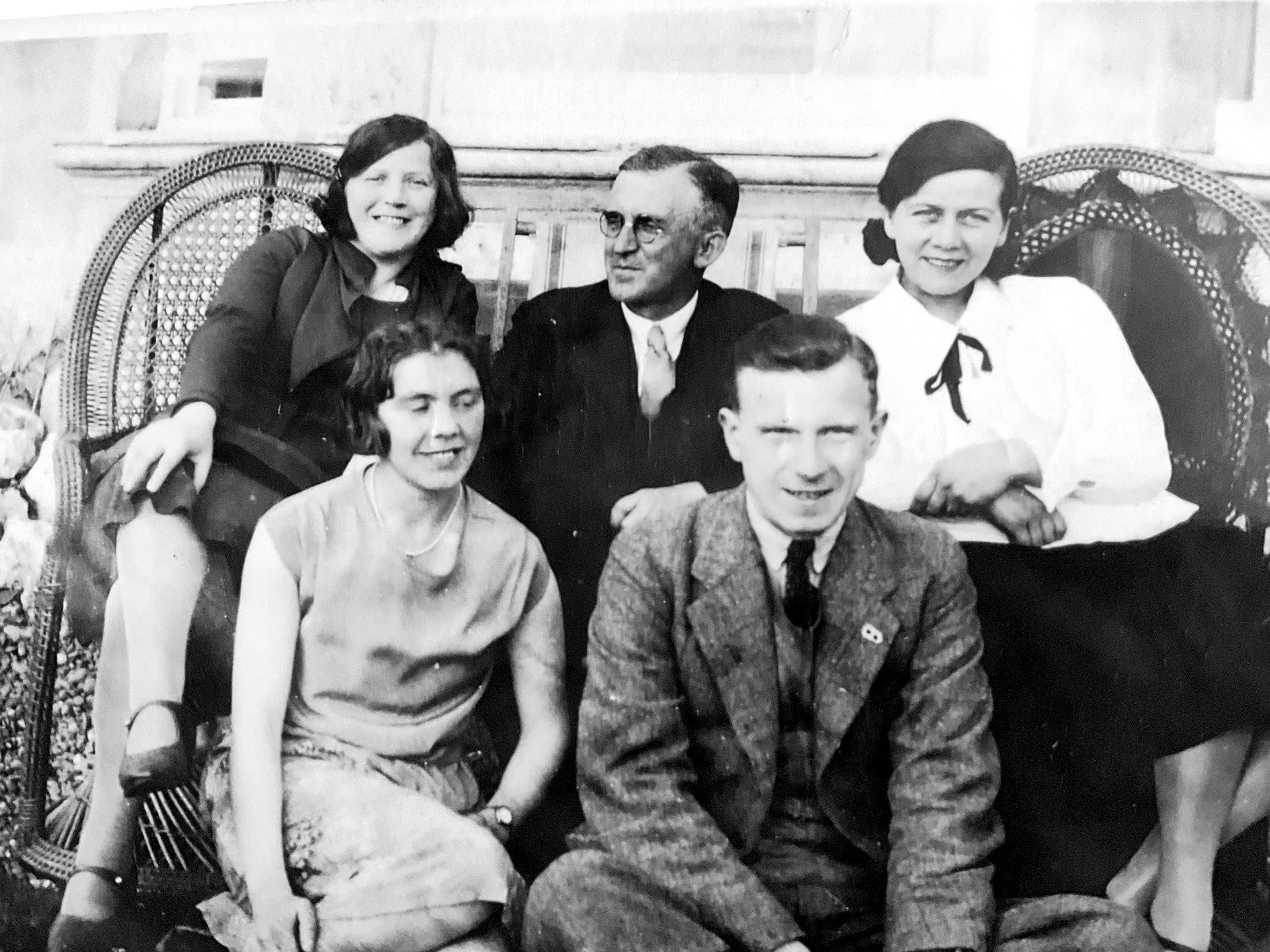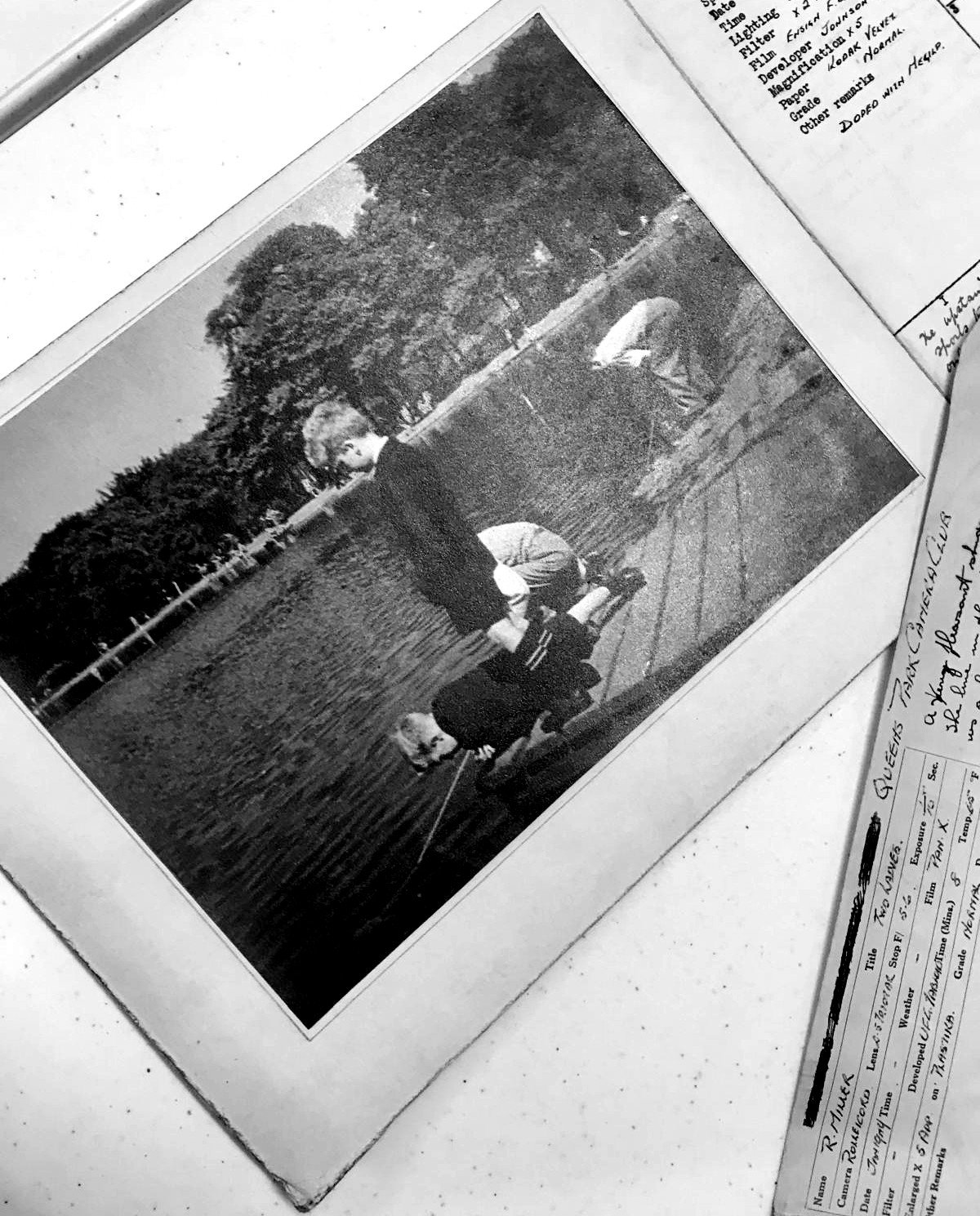Dusting off the memories: On the importance of archives
Archives exist as a means to connect us to our past, whether personal, social or connected to a particular place or movement. Preserving these stories provides a chance to learn from what’s gone before. In this article we explore the personal archive of a former Queen’s Park Camera member and share some of the interesting local archives available in the Southside.
Robert Miller and his family.
By Devon McCole | Photos courtesy of the family of Robert Miller, with thanks to the Queen’s Park Camera Club
Sitting in one of the small booths in The Church on The Hill, I nurse my drink while waiting for Lesley. I spot her scanning the room for me, her hands full. I wave her over and, after hastily making room for the two large photo albums she’s brought, we take a seat.
“I’m not quite sure what to tell you,” Lesley begins. “My father died when I was only two.” A staff member briefly interrupts us, placing a cup of coffee on the table. “He was always a keen photographer, and my mother never threw anything out. I suppose I’m lucky in that way.”
It’s my first time meeting Lesley. We were introduced through the Queen’s Park Camera Club (QPCC) after she dropped off boxes of old photographs belonging to her dad, Robert Miller.
Robert's Eastwood Photographic Society syllabus from 1945.
“He was a member of Eastwood Photographic Society. He grew up in Clarkston and joined because it was the nearest. When he married my mother, they moved to Tantallon Road, and I imagine he joined QPCC because it was closer.”
Lesley opens one of the albums, revealing black and white photos beautifully capturing family moments and landscapes. “Unfortunately, we don't know who a lot of the people are,” she says, pointing to the smiling figures. “I think these are my grandparents and great-grandparents. I didn’t get to know my dad’s side of the family well. He was only 48 when he died.”
From the photographs, I sense the warmth of the family, tightly packed together, squinting in the sun. “In the ‘30s my father had a great social life. There he is on the beach with friends, and there he is with his tennis racket,” Lesley points to a portrait of her father, smartly dressed, with slicked-back hair, the iconic tenements of the Southside in the background. “They had a wonderful time.”
Robert holding his tennis racket.
In another photograph, I see a handsome young couple - Lesley’s parents - gazing down lovingly at a newborn baby in white. “This is either me or my brother getting christened. All of my siblings were christened here, that was when it was a church and not a bar and restaurant.”
I had no idea of this coincidence when I’d suggested The Church on the Hill for our meeting. It is even more surprising to me that, despite never knowing her father, Lesley tells me so much about him and his relationship with her mother – gleaned through photographs, letters, and stories passed down over the years. I get a real sense of their lives, adventures, and personalities as she talks.
Robert and Jessie at their child's christening.
“My father met my mother through his work; he was a construction surveyor for a company called Limmer and Trinidad. My mother lived in Oykel, Sutherland, and that’s where he met my mother. They met at a local dance there. He started courting her, and they wrote letters to each other. We have all their correspondence from day one.”
She shows me one of these letters. In a particularly funny exchange, the first paragraph reads: “Dear Jessie, your last letter was interesting and enjoyable but a little out of date. You may be beautiful, intelligent, and a good nurse but you’re a damned bad correspondent. Even a P.C (post card) would bring more excitement to my monotonous life.”
A letter from Robert to Jessie.
We laugh at this, and Lesley tells me it’s nothing compared to some of the “rather scathing” notes left for her father about his photographs, written by other camera club members trying to help him improve his technique. “At least I think that was their intention,” she jokes.
Sure enough, some photos have yellowing notes attached, with comments written in sprawling cursive that, to my Gen Z eye, is almost illegible. One comment compliments Robert on a portrait of Lesley’s rosy cheeked brother as a toddler, although follows it with: ‘But pity! What a shame it is that the image is out of focus. It has a slightly fuzzy appearance’. The author was kind enough to leave tips to improve this.
Robert's photograph of young boys playing by the Queen's Park pond, with other camera club members feedback attached.
Speaking about these notes, Lesley says: "They were lovely to see, and we found the criticism amusing. I don't know if I would have survived it, but it seemed a shame to throw them out. When I was clearing out my sister’s house after she passed, I found so many boxes of photographs and letters I thought I should donate some to the QPCC."
Robert’s photos and the letters between him and Lesley’s mother, Jessie, showcase not only family history but also the camera club’s history – and sheds some light into life during wartime: "My mother was training to be a nurse in Leith Hospital at the time. They brought the wedding forward because Leith docks were being bombed."
I’m moved by her parents' chance meeting, their long-distance correspondence, and their enduring love during wartime, and can only imagine how Robert’s death affected the family.
“When my father died, my mother was left with four children on a widow's pension. It hit her hard. Sadly many women were on widow’s pensions at the time because of the war. My father had died suddenly of a heart attack, something that might have been less life threatening today. But she was incredible. She was never in debt and gave us all the opportunities we wanted."
The challenges and joys of preserving these family memories are clear. There’s a sense of loss in Lesley’s story and plenty of gaps in her knowledge of who is who, but the annotated photographs and letters left by her father serve as a profound gain. They are a tangible connection to these memories and the people that held onto them, keeping the past alive. They are a treasure trove of memories, needing only to be dusted off for the lost to be found again.
I tell Lesley it is a beautiful gift to leave behind and we part ways after spending so much time reflecting on the past and the power of recording your own history. For Lesley, the traces left by her parents are worth more than their weight in gold, preserving a family history that could have so easily been lost to time… I imagine Robert could never have known how valuable they would be to his young daughter at the time.
An introduction to community archives
Society isn’t fixed. It fluctuates. Like most things in life, the here and now is fleeting; here one minute and gone the next, lost and forgotten, eroded by the tides of time.
And, whilst the future might be unknown, the here and now exists in this very moment. One day we'll look back at today with the same nostalgia that people now for the distant – or not so distant – past, trying to piece together how things have changed and what was lost or gained over time.
The Cambridge dictionary defines an archive as ‘a collection of historicalrecordsrelating to a place, organisation, or family.’ Lesley’s archive is a deeply personal one. But archives also represent the collective memory of a place or group, and the stories contained within them tell us the stories of a Scotland we live in today. In Govanhill, and across Glasgow, there are a number of community archives for people to learn from or get involved with.
Interested in visiting or contributing to a community archive?
There are many more out there, we’d love to know about the Glasgow archives you know of so we can publish a full list. Please get in touch via newsroom@greatergovanhill.com to tell us more.
The Baths Archive
The Govanhill Baths Archive catalogues a unique collection of materials reflecting the wide range of activities at the Baths over the past 100 years, from its use as a municipal swimming baths and wash house, through the Save Our Pool campaign, to the development of the Govanhill Baths Community Trust. The archive is accessible both at the Baths and online, preserving the building’s history and promoting education, health, and wellbeing in the diverse community.
Web: www.govanhillbaths.com/archive/ to access some of their materials online
Address: The Deep End, 21 Nithsdale St, G41 2PZ , open from 9am-4pm
Call them: 0141 433 2999, to arrange a visit
Romano Lav Community Archive - coming soon!
Romano Lav are developing a digital community archive and are in the process of creating a body of work that will represent Roma culture, history and diversity for everybody to enjoy or appreciate. The purpose of this is to ensure Roma communities are properly represented. In the process of shaping the Romano Lav digital archive, they are asking local people of a Roma background to fill out a short survey to assist them with their collection. This can be found on their website:
Web: www.romanolav.org/community-archive
Address: 43 Nithsdale Street, G41 2PZ
Contact them: hello@romanolav.org













